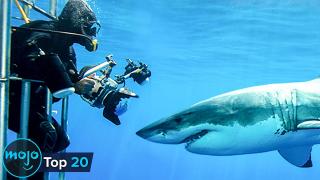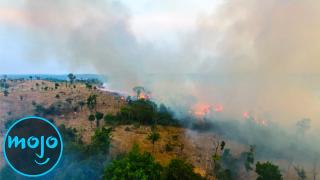Top 20 Most Dangerous Tourist Destinations

#20: Mont Blanc
Meaning “white mountain,” Mont Blanc lies between France and Italy and is the highest mountain in the Alps. Rising over 15,000 feet, it’s a popular destination for all sorts of winter and mountain-based activities, including skiing, climbing, and hiking. But the beauty of the mountain and the surrounding area is deceiving, as Mont Blanc is incredibly dangerous. It’s been estimated that between ten and twenty people die on the mountain every year. This makes Mont Blanc the deadliest mountain in the world - even deadlier than big hitters like K2 and Everest. Everyone thinks they can handle a pretty mountain, but reality can often prove otherwise.
#19: Yellowstone National Park
What If the Yellowstone Supervolcano Erupts? | Unveiled
Spanning over 3,000 square miles in the western United States, Yellowstone is widely touted as the first national park in the world. Established back in 1872, Yellowstone has been a popular tourist destination for well over a century. The area is well known for its geothermal activity and spouting geysers, but these have resulted in over twenty deaths and countless other injuries - some serious, some unreported. But it’s not just the geysers that people have to look out for. Tourists die every single year by drowning in pools and falling off cliffs. It’s a gorgeous park, but one whose inherent danger needs to be respected.
#18: Colorado River
One of the great rivers of the world, the Colorado River spans nearly 1,500 miles. And despite its name, the river actually travels through multiple states, including Arizona and California. It offers multiple recreational activities, but it’s known far and wide for its whitewater rapids. Unfortunately, people underestimate just how dangerous these rapids can be. Hundreds of people have been injured or killed on the river, with rafting inexperience playing a large role in the incidents. Whitewater rafting sounds like fun, but it is no joke, and many people have learned that the hard way.
#17: Madidi National Park
Found in Bolivia, Madidi National Park is a massive and biologically diverse region. Because it spans from the Andes Mountains to the Tuichi River, Madidi contains everything from snowy glaciers to tropical rainforests. Like any park, Madidi has its dangers. It’s home to nearly 300 species of wild mammals, not to mention 120,000 species of insects. It’s also easy for tourists to get lost in the vast region of the Bolivian Amazon, so tour guides are an absolute must. The fierce weather is another obstacle to overcome. In 2015, for instance, a young tourist named Louise Shepherd was caught in a violent storm and crushed by a falling tree. All parks have their dangers, especially one as large and diverse as Madidi.
#16: New Smyrna Beach
20 Most Dangerous Tourist Activities in the World
Often ranked as one of the best surf towns in the world, Florida’s New Smyrna Beach is home to about 30,000 people. It’s obviously a hotspot for surfing, but it also hosts a slew of other water activities like diving and fishing. Unfortunately, it’s also earned the unofficial distinction of being the shark attack capital of the world. There were twenty-four reported shark bites in 2008 alone, and on September 18, 2016, three separate surfers were bitten in the span of just a few hours. Florida led the world in shark attacks in 2019, with nine of the state’s twenty-one incidents taking place in the area of New Smyrna Beach. It’s practically like “Jaws” out there, and surfers would do well to take heed.
#15: Snake Island
Top 10 Real Life Snake Attack Stories
A place like Snake Island gets its name for a reason. Officially titled Ilha da Queimada Grande, Snake Island is found off the southeastern coast of Brazil. It’s quite a fascinating place, as it’s filled with highly venomous golden lancehead vipers. Rising sea levels have trapped the snakes on the island, and it’s now their only home in the world. Access to the island is mostly prohibited, but it still welcomes members of the Brazilian Navy and academics studying biodiversity. These visitors are forced to take extreme safety measures, as golden lanceheads are highly venomous. Estimates place the snake population at one per square meter, meaning there’s a deadly snake within a few feet in any direction. No thanks.
#14: Mount Washington
Top 10 Creepiest Mount Everest Mysteries
Found in the northeastern United States, Mount Washington is a popular tourist destination for hiking and skiing. The mountain is well known for its horrific weather, with the Mount Washington Observatory bearing the slogan “Home of the World’s Worst Weather.” The worst part about the mountain’s weather is the wind. For over sixty years, Mount Washington held the world wind speed record when winds of 231 miles per hour were captured at its summit. Structures at the top of the mountain are literally chained to the ground to prevent them being destroyed. Numerous people have died while hiking, and six have perished in avalanches. In fact, it’s estimated that over 160 people have died on the mountain since 1849.
#13: Lake Natron
Known for its distinct red color, Tanzania’s Lake Natron is physically wondrous. The beauty is aided by the presence of wild flamingos, as Natron is the only breeding ground in East Africa for lesser flamingos. Camping is a popular activity in the area, and many climb the nearby volcano. But they would do well to stay clear of the water. It is the most caustic body of water in the world, with a pH level greater than 12. This water is incredibly dangerous, and the lack of competing animals and predators allows the flamingos to thrive. The water can reach temperatures of 140 degrees Fahrenheit and at times has the alkalinity of ammonia. So does that mean no swimming? Bummer.
#12: Sumatra
The sixth largest island in the world at over 180,000 square miles, Sumatra is part of Indonesia’s Sunda Islands. As of 2020, it is home to nearly 60 million people. Despite its vast number of inhabitants, Sumatra is not to be underestimated. The island is home to active volcanoes and contains many treacherous rivers, forests, and swamps. Dangerous animals like rhinoceroses and tigers can also be found on the island. It’s also highly prone to natural disasters like earthquakes and tsunamis. In 2004, Sumatra was battered by the Indian Ocean tsunami, resulting in approximately 170,000 lost lives. Visitors would do well to prepare.
#11: Running of the Bulls
Why Scientists Are So Worried About Running Out Of Helium | Unveiled
Surprise surprise, running in front of charging bulls is not a great idea. Every year between July 6 and 14, the Spanish city of Pamplona hosts the San Fermín Festival, of which the running of the bulls is the main attraction. The event obviously brings many dangers, including exhaustion, pile-ups, and of course, being gored by a running bull. It’s estimated that between 50 and 100 people are injured in the bull run each year, and fifteen have died since 1910 - including tourists from Mexico and the United States. All but one of these deaths was a result of goring. The exception was a Spanish teenager who suffocated in a pile-up in 1977.
#10: Rio de Janeiro
Top 10 Tourist Traps to Beware Of
World-famous for its beaches, landmarks, and world-class hotels, Rio receives approximately three million tourists every year, making it South America’s most popular destination. But the sheer number of people makes visiting Rio a risk, as criminals abound in the popular tourist districts. Carjackings and muggings are common, and pickpockets take advantage of crowded beaches and carnivals. Rio is also known for express kidnappings, which is when a criminal holds someone ransom and demands they withdraw money from an ATM. Street violence is also frequent, with police in the state killing an estimated 1,800 people in 2019 alone - an average of five deaths per day.
#9: Death Valley
20 Shocking Facts About Living on Death Row
Maybe it’s best to just stay clear of a place called Death Valley. Found on the California-Nevada border in the northern Mojave Desert, Death Valley is a dry, barren, and horrifically hot location. There are many notable attractions within Death Valley that have made it a popular tourist destination, including Dante’s View, Darwin Falls, and the Badwater Basin. However, the area gets brutally hot in the summer, with average highs of around 115 degrees Fahrenheit in July and August. Not surprisingly, this unforgiving climate wreaks havoc on unprepared hikers and tourists. People die every single year inside Death Valley, and the area saw six fatalities in 2021.
#8: Cliffs of Moher
Found on the western coast of Ireland are the Cliffs of Moher. They rise between roughly 400 and 700 feet above the Atlantic Ocean, and the gorgeous views have made the cliffs one of the most popular tourist destinations in the country. It’s also the most dangerous. It goes without saying that cliffs rising 700 feet above the water are dangerous, and one small misstep can spell disaster. The cliffs saw 66 deaths between 1993 and 2017, and roughly one-third of the deceased were tourists. The dangers are especially prevalent today, as some people have died taking selfies near the cliff’s edge.
#7: Half Dome
What Happens If Half Of Humanity Dies? | Unveiled
Found at the eastern end of Yosemite Valley is Half Dome, a massive, granite dome rising over 4,700 feet above the valley floor. Half Dome gets its name from its distinct appearance, as the rock looks like a smooth dome that has been sheared in half. It’s a popular destination for climbing and hiking, and about 50,000 people climb the rock every year. But accidents are common, including falls and even unfortunate lightning strikes. Between 2005 and 2019, thirteen people died attempting to summit Half Dome and hundreds more were injured or incapacitated to the point of needing rescue.
#6: Devil’s Pool
What If We Proved The Devil? | Unveiled
Seriously, what is with these ominous names? And why do tourists flock to them!? Devil’s Pool is located at the top of Zambia and Zimbabwe’s Victoria Falls, and it’s essentially a little pocket where swimmers can rest and look over the edge. Swimmers are stopped only by a slimy little rock lip, and it allows them to gaze down the over 300-foot-high waterfall while water rushes around them. The danger goes without saying. Devil’s Pool is only available from August to January, as the country’s dry season reduces the water level and exposes the rock lip. If someone was to try this any other time of the year? In the words of Zambia’s tourism website, “[they] would be instantly swept to their deaths.”
#5: Tijuana
Found on the border of California and Mexico, Tijuana is Mexico’s second-largest city and part of the Southern California megalopolis. Because of its close proximity to the border, Tijuana gets scores of American tourists who come across for a fun weekend. The city’s draws include a thriving nightlife, low drinking age, and even a legal red light district. Unfortunately, these tourists are often taken advantage of, and some have even been robbed by the local police. But there’s something even worse, and that’s Tijuana’s high mortality rate. There are roughly 138 homicides per 100,000 people, statistically making Tijuana the deadliest city in the world.
#4: The Chernobyl Exclusion Zone
What If You Lived In Chernobyl?
Life is not back to normal around Chernobyl. In fact, it probably won’t be habitable in the near future. Or the distant future, either. It’s pretty much a lost cause at this point. But that’s not to say you can’t visit it. Dozens of tour companies allow access into the Chernobyl Exclusion Zone, and staying there for a short amount of time is relatively safe. However, radioactive isotopes continue to linger in the area, so staying for too long can result in harmful doses of radiation. Tourists are also advised against touching things, as certain objects may prove dangerously radioactive. Still, you can’t beat it if you’re a fan of ghost towns!
#3: Mount Everest
Tough Rides: China, Episode 5: Mount Everest and Lhasa
The granddaddy of all mountains, Everest has an undeniable legacy. This legacy has made it a popular tourist destination, even though it stretches nearly 30,000 feet into the sky. Everest is surprisingly popular, with Nepal granting hundreds of climbing permits each year. But as books like “Into Thin Air” argue, most people simply aren’t ready to tackle the rigors of Everest, no matter how experienced they may think themselves. Over 300 people have died climbing the mountain, and their frozen bodies remain half-buried in the snow. As if climbing the darn thing wasn’t scary enough. Most of the fatalities are attributed to avalanches and falls, but things like exposure, altitude sickness, cardiac arrest, and strokes are also significant risk factors.
#2: North Korea
Top 10 Ridiculous Facts About North Korea
Arguably the worst country on Earth in terms of human rights, North Korea doesn’t exactly spell “beautiful weekend away.” But despite its secrecy, North Korea does indeed welcome tourists. With some caveats, of course. Tourism is strictly controlled by the North Korean government, and all tourists are forced to undertake guided tours. People see only what they’re allowed to see, and veering from the group is strictly prohibited. The biggest cautionary tale in that regard is the story of Otto Warmbier. Warmbier was a young college student who allegedly tried stealing a propaganda poster and was subsequently sentenced to fifteen years hard labor. He returned to the United States completely brain dead and passed away shortly after.
#1: The Amazon Rainforest
What If The Amazon Rainforest Was Destroyed?
Here’s a good tip for going into the Amazon rainforest - don’t. For one thing, the area is mind-bogglingly large, with the entire basin covering nearly three million square miles. While people are trying not to get lost in the dense expanse, they’re being accosted by a wide variety of dangerous animals, including cougars, disease-carrying insects, and venomous snakes. Even the water isn’t safe, as it’s populated by the likes of piranhas and electric eels. The local tribes can also prove dangerous, as evidenced by the violent deaths of Brazilian Rieli Franciscato and Canadian Sebastian Woodroffe. The Amazon Rainforest is a melting pot of danger and death, and visiting it does not come recommended.














